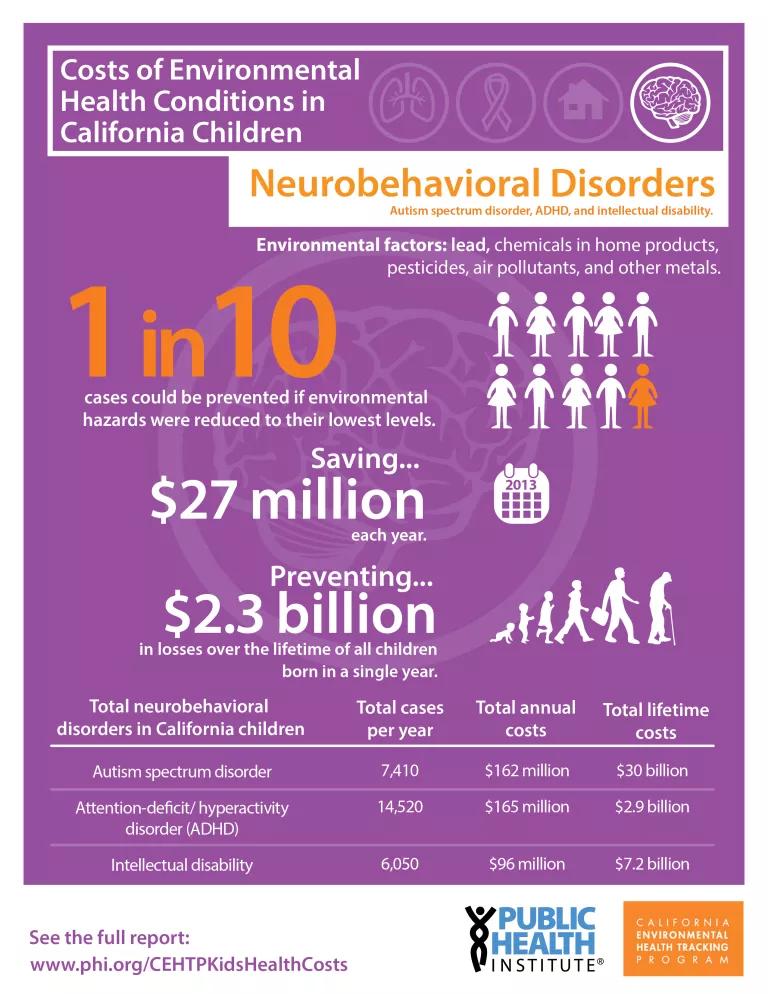Toxic chemicals harm the health of California children, costing millions of dollars every year

$254 million every year --that's the toll that preventable environmental hazards like lead, pesticides, and air pollution take on children's health in California, according to a new report from the Public Health Institute.
These environmental hazards are linked to a variety of diseases, and the report specifically focused on asthma, cancer, lead exposures and neurobehavioral disorders like attention-deficit/hyperactivity disorder (ADHD) in California children. For each of these diseases, environmental factors like toxic chemical exposures contribute to a certain percentage of the cases each year. For example, the report found that approximately 10% of cases of the neurobehavioral disorders studied are due to environmental hazards including pesticide exposures, air pollution, and chemicals in household products.
Above: A new report from the Public Health Institute looked at the costs of asthma, cancer, neurobehavioral disorders and lead exposures in California children. Preventable environmental hazards contribute to a certain fraction of each of these diseases, for example, 10% of the neurobehavioral disorders studied.
The analysis also found that 30% of asthma cases, 100% of lead exposures, and 15% of childhood cancers studied could be prevented-- this could be done through measures such as creating policies that ensure that communities near agricultural fields are not exposed to unsafe levels of cancer-causing or brain-harming pesticides. If the environmental factors that cause these diseases could be reduced to their lowest feasible level, $254 million could be saved every year (annually) by preventing and alleviating these serious diseases in children. To put that number in perspective, that's equivalent to these amounts from California's 2014-15 budget:
- Funding for local teacher training programs for the entire state or,
- Almost double the size of funding for child nutrition programs or,
- Funding for career technical education programs for the entire state.
The report also looked at the costs of these diseases over the lifetime of children born in one year in California.

Above: According to the Public Health Institute report, diseases due to preventable environmental hazards cost $10-13 billion dollars over the lifetime of children born in one year in California.
Costs come from direct costs like medical care, indirect costs like lost parental earnings due to child care, and lost potential earnings in the child's lifetime.
Autism spectrum disorder, attention-deficit/ hyperactivity disorder, and intellectual disability are neurobehavioral disorders linked to chemicals including flame retardants, pesticides, and perchlorate.

Above: Infographic from the Public Health Institute report summarizing the findings on preventable neurobehavioral disorders in California children.
If all places in California were free of unsafe levels of these hazards, approximately 1,800 cases of these diseases could be prevented in kids every year, saving $27 million annually. According to data from the Lucile Packard Foundation for Children's Health, that's equivalent to ALL the kids in special education in less populated counties in California, such as Yuba or Mendocino, and about 25% of the kids in special ed in San Francisco County.
So what can we do to make every county, community, and kitchen in California a healthy place for babies and children to grow, live, learn, and thrive?
Agricultural communities should be safe from hazardous pesticides
Another recent study identified neurotoxic organophosphate pesticides, like chlorpyrifos, as the prime contributor to costs due to loss of IQ and intellectual disability. These pesticides can drift away from fields to the nearby homes, yards, and schools of communities, resulting in toxic exposures that can harm a baby's brain development, especially before birth. A child's potential shouldn't be determined by whether they happen to live near a field or a forest-- California needs better policies to protect communities from unsafe pesticide exposures, starting with chlorpyrifos.
Make food and water safe for all communities
The chemical perchlorate disrupts normal brain development and contaminates drinking water at higher levels in certain places, such as those that had facilities that produced, used or stored rocket fuel. California is in the process of setting a drinking water standard for perchlorate-- the standard needs to be set at a level that will be protect pregnant women and babies in communities across the state. The analysis in this report indicates that the return on investment in such a standard would be incredible, and then some.
Recent evidence indicates that early life exposures to the hormone-disrupting chemical BPA are strongly associated with altered neurodevelopment and behavior in children. BPA is commonly used in the lining of food and beverage cans--California needs to move forward with the "Proposition 65" listing process for BPA, so consumers can be warned when products contain this toxic chemical.
Replace toxic chemicals in our everyday products with safe alternatives
Finally, other hormone disrupting chemicals like phthalates are used in a disconcerting variety of our everyday products, including cosmetics, lotion, vinyl flooring, and plastic toys. Studies increasingly link phthalates, especially prenatal exposures, to IQ loss and deficits in children's intellectual development. We need to see scale-up of comprehensive programs and policies like California's Safer Consumer Products that promote the elimination of toxic chemicals in products in favor of safe alternatives.



